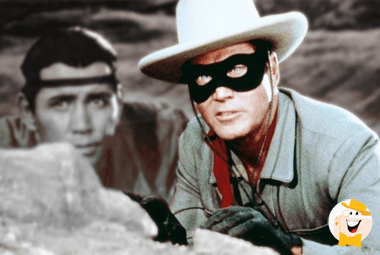
Kingman, AZ. sits along a cactus-studded highway about 90 miles south of Las Vegas, NV. It is a medium-sized desert community with a valley of large boulders that were used to film many television westerns and movies during the heyday of the Golden West when such movies were popular.
I lived in Kingman for more than a year...
...working as a reporter on a newspaper and writing dozens of short stories and articles about the old West. I enjoyed my stay there for several reasons. Kingman was only 23 miles from a colorful ghost town named Oatman and if you drove just a few miles farther, you would be in Laughlin, NV. with nine gambling casinos strewn along the Colorado River.
One of the locals discovered I was a writer
She told me two well-known actors had ties to Kingman. One was Andy Devine, a character actor who starred in many westerns and who was born in the town. The other was Clayton Moore, who played the Lone Ranger in the long-running television series.

Moore had starred in 169 of 221 episodes of the series and had retired to Kingman where many of the shows were filmed. I found out where he lived and drove to his place to try to get an interview.
The retired actorWas proven to be a perfect gentleman. He welcomed me into his adobe home, brewed a pot of strong coffee, and regaled me with tales about his experiences as an actor with Jay Silverheels playing as his faithful Indian companion, Tonto.
Moore was born in Chicago and began his career as an acrobat. A talent scout in Hollywood was impressed with his good looks and got him a role in 'The Ghost of Zorro.'
He performed well in the film and that led him to be signed as the lead role in the first western series ever made for television. It was about a Texas Ranger who was the only survivor of a massacre and who donned a mask to make him a champion of law and order. He was known as The Lone Ranger.
The theme music for the new series was taken from 'The March of the Swiss Soldiers' finale as part of Rossini's William Tell Overture. It became ABC Television's highest rated program during its long era.
Moore was eventually replaced as the Lone Ranger by Jack Wrather, who owned the rights to the character. Moore strongly resisted the change and began making personal appearances in rodeos and other public events wearing the mask and dressed like the television character.
Wrather was so angry
He secured a court order prohibiting Moore from making future appearances. Moore countersued and took the issue to court. A judge ruled in his favor, rocking Wrather with unfavorable publicity. He backed off and Moore continued making personal appearances until the end of his life. He even wrote a best-selling book titled 'I Was That Masked Man.'
Before our interview ended, I asked Moore if he played poker. He pretended to be offended by the question.
'What? The Lone Ranger a gambler? Never, my friend. That would violate the Masked Man's principles and I would never do that to upset my young audience,' he said.
Jay Silverheels
He was a Mohawk Indian born in Canada. As a young man, he played lacrosse and was a successful athlete who won numerous awards. He went to Hollywood, was talked into taking a screen test, and appeared in a number of successful films including 'Captain From Castille,' 'Key Largo' with Humphrey Bogart, 'Broken Arrow' with Jeff Chandler,' 'The Man Who Loved Cat Dancing' and other western films and television series before accepting the role of Tonto.

Moore told me a hilarious tale about one of the segments of 'The Lone Raner' that was shot near Kingman. The script called for The Lone Ranger and Tonto to race up a hill on their horses, dismount behind some rocks, and for Tonto to peer into the distance and say, 'Look, Kemo Sabe, smoke signals.'
Silverheels was a two pack a day cigarette smoker. By the time they arrived at their dismounting place, he was so out of breath all he could utter was, 'Look, Kemo Sabe, smoke sniggles.'
The director...
...called for them to do it again. By this time Silverheels was totally winded and he had the giggles. Again 'smoke signals' became 'smoke sniggles' and the director, in disgust, told the cast, 'Go home. We'll shoot this tomorrow.'
Moore is on the Hollywood Walk of Fame. His star reads 'Clayton Moore, The Lone Ranger,' a title he richly deserved. He died at 85 of heart failure and is buried at Forest Lawn Cemetery in Los Angeles.








0 comments:
Post a Comment